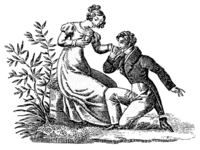

A marriage proposal is a custom or ritual, common in Western cultures, in which one member of a couple asks the other for their hand in marriage. If accepted, it marks the initiation of engagement, a mutual promise of later marriage.
Not all engagements begin with a proposal of marriage. Historically, many marriages have been arranged by parents or matchmakers, and these customs are still sometimes practiced in the modern day. Even when the decision to marry is made by the couple, it may not be communicated between them directly; for instance, in the traditional Japanese custom of Omiai, the formal decision to pursue marriage or to turn it down (Kotowari) is communicated between the couple's respective matchmakers.[1]
Customs and traditions
In Western cultures, a proposal is traditionally made by a man to a woman, while genuflecting in front of her. The ritual often involves the formal asking of the question "Will you marry me, ...?" and the presentation of an engagement ring (often in a small velvet box), which he may place on her finger if she accepts.[2][3]
Before proposing, a man traditionally privately asks permission from the father of the woman he hopes to marry.[4] When practiced in the modern day, this is usually understood as a formality.[5]
The proposal itself is often supposed to be a surprise, although in practice this is rarely actually the case.[6] Surveys have found that most proposals are not surprises, and most wedding engagements begin with a conversation in which the parties mutually agree to wed.[7]
Couples in many Christian denominations have the option of receiving the Rite of Betrothal (also known as 'blessing an engaged couple' or 'declaration of intention'), which often includes prayer, Bible readings, blessing of engagement rings, and a blessing of the couple.[8][9][10]
Gender roles
While the common Western convention is for a man to propose to a woman, there are some traditional exceptions. For instance, as a monarch, Queen Victoria had to propose to Prince Albert.[11] Folk traditions in countries including Scotland, Ireland, England, and Finland allow women to propose on leap days, sometimes with the addition that a man rejecting such a proposal was expected to pay a forfeit to his suitor, usually in the form of a gift of clothing.[12][13][14]
Proposals by women are increasingly accepted in Western culture, with most Americans approving of the practice, although the vast majority of proposals in the United States are still made by men.[15][16] In response to the demand created by this cultural shift, jewelry companies have begun to advertise engagement rings for men.[17] Nevertheless, proposals by women may not be taken seriously or treated as "real" proposals.[18]
Gay and lesbian couples, to whom the traditional gendered proposal does not apply, usually keep some elements of the established ritual while altering others. In some cases, there may be multiple proposals, and each partner may propose to the other.[19]
See also
References
- ↑ Alpert, Erika Renee (2014). Language, Gender, and Ideology in Japanese Professional Matchmaking (PhD). University of Michigan. hdl:2027.42/107171.
- ↑ Kamen, Gloria; Martin, Judith (2011). Miss Manners' Guide to Excruciatingly Correct Behavior (Freshly Updated). New York: W. W. Norton & Company. p. 760. ISBN 9780393079098.
1. Arrange the lady on a sofa. 2. Kneel in front of her. That should put her into shock. If she is still able to talk and says something like, "What do you think you're doing?" simply smile mysteriously. 3. Pull out of your pocket a small velvet box with an engagement ring inside. That should put her back into shock, giving you the opportunity to perform the next step, while you are still holding the box. 4. Say "I can't live without you. Will you marry me?" Got that? Not "I think we might make a go of it," or "My mother says she's tired of her friends asking when we're getting married," or "I've talked to my tax consultant, and I think we can get married without getting hit too badly." 5. Open the box, take her hand and put the ring on her finger. 6. Congratulations. You are now engaged.
- ↑ Schweingruber, D; Anahita, S; Berns, N (2004). "'Popping the Question' When the Answer Is Known: The Engagement Proposal as Performance". Sociological Focus. 37 (2): 148.
The majority of the proposals in this study contained five elements. Three were found in every proposal: (1) the man asking the woman to marry him, (2) the man presenting the woman a ring, and (3) the man orchestrating the proposal as a "surprise." Another element, the man getting down on one knee, was found in 17 of the 20 proposals. The final element, the man asking permission of the woman's father, was found in 12 of the 20 proposals.
- ↑ Post, Emily (1922). Etiquette in Society, in Business, in Politics, and at Home. New York and London: Funk & Wagnalls Company.
If a young man and his parents are very close friends it is more than likely he will already have told them of the seriousness of his intentions. Very possibly he has asked his father's financial assistance, or at least discussed ways and means, but as soon as he and she have definitely made up their minds that they want to marry each other, it is the immediate duty of the man to go to the girl's father or her guardian, and ask his consent. If her father refuses, the engagement cannot exist. The man must then try, through work or other proof of stability and seriousness, to win the father's approval. Failing in that, the young woman is faced with dismissing him or marrying in opposition to her parents. There are, of course, unreasonable and obdurate parents, but it is needless to point out that a young woman assumes a very great risk who takes her future into her own hands and elopes [...] Usually, however, when the young man enters the study or office of her father, the latter has a perfectly good idea of what he has come to say and, having allowed his attentions, is probably willing to accept his daughter's choice.
- ↑ Kamen, Gloria; Martin, Judith (2011). Miss Manners' Guide to Excruciatingly Correct Behavior (Freshly Updated). New York: W. W. Norton & Company. p. 775. ISBN 9780393079098.
Asking the father for his daughter's hand may have been superfluous—as a gentleman of Miss Manners' acquaintance replied in similar circumstances, "Why not? You've already had the rest of her"—but you nevertheless found it charming.
- ↑ Kamen, Gloria; Martin, Judith (2011). Miss Manners' Guide to Excruciatingly Correct Behavior (Freshly Updated). New York: W. W. Norton & Company. p. 759. ISBN 9780393079098.
Now that weddings have become drama festivals, the marriage proposal has turned into a pageant that serves as the curtain raiser. Unlike the main events, this has a sole producer, the future bridegroom, and what he is supposed to produce is—a surprise. Miss Manners can imagine that it is not easy to surprise a lady whose relatives have been asking her for years if the two of them were ever getting married, and who may even have been asking the question herself. However, valiant tries are made. Romantic trips provide the scenery, and a hidden ring (preferably not hidden in something the lady goes ahead and drinks) is the prop. [...] The truth is that surprise was never a successful element of the proposal. Ladies who blushed and protested that they had never thought of such a thing (but would start doing so right away) were merely meeting expectations.
- ↑ Weiss, Suzannah (2020-11-18). "Forget the Fancy Proposal. Let's Just Get Married". The New York Times. ISSN 0362-4331. Archived from the original on 2020-11-22. Retrieved 2020-11-23.
- ↑ "Rites Relating to Marriage: A Statement and Resources from The International Anglican Liturgical Consultation" (PDF). The International Anglican Liturgical Consultation. 2011. pp. 4, 14–15. Archived (PDF) from the original on 20 September 2021. Retrieved 19 September 2021.
- ↑ Aabram, Virginia (29 August 2021). "What Is the Rite of Betrothal?". National Catholic Register. Archived from the original on 20 September 2021. Retrieved 19 September 2021.
- ↑ "A Brief Liturgy for the Signing of the Declaration of Intention" (PDF). Anglican Church in North America. 2019. p. 213-214. Archived (PDF) from the original on 20 September 2021. Retrieved 19 September 2021.
- ↑ Dolby, Karen (2018). My Dearest, Dearest Albert: Queen Victoria's Life Through Her Letters and Journals. London: Michael O'Mara Books.
As royal tradition dictated that no one could propose to a reigning monarch, Victoria asked Albert to marry her on 15 October 1839.
- ↑ "Leap Year Proposal: What's The Story Behind It?". Huffingtonpost.com. 2012-02-29. Archived from the original on 2014-10-21. Retrieved 2014-08-11.
- ↑ Jowett, Adam; Peel, Elizabeth (2019). "Reshaping relational scripts? Marriage and civil partnership proposals among same-gender couples". Psychology & Sexuality. 10 (4): 1.
Tradition dictates that men are expected to play the active role of initiating the proposal, while women are expected to adopt a passive and reactive role (Schweingruber, Anahita, & Berns, 2004). Although in some European countries – such as Finland and Ireland – there is the custom that women are permitted to propose during a leap year, this is the exception that proves the cultural rule.
- ↑ Marriage Customs of the World: An Encyclopedia of Dating Customs and Wedding Traditions, Expanded Second Edition [2 Volumes] George Monger ABC-CLIO, Apr 9, 2013
- ↑ "Why don't women propose to men?". CBS News. 2014-05-05. Archived from the original on 2017-12-22. Retrieved 2015-05-07.
- ↑ Kamen, Gloria; Martin, Judith (2011). Miss Manners' Guide to Excruciatingly Correct Behavior (Freshly Updated). New York: W. W. Norton & Company. p. 761. ISBN 9780393079098.
Mind you, [Miss Manners] believes it is as appropriate for the lady to propose to the gentleman as it is for a gentleman to propose to a lady.
- ↑ "Australian news article about women proposing". Smh.com.au. 2004-02-29. Archived from the original on 2017-12-02. Retrieved 2014-08-11.
- ↑ Schweingruber, D; Anahita, S; Berns, N (2004). "'Popping the Question' When the Answer Is Known: The Engagement Proposal as Performance". Sociological Focus. 37 (2): 148.
A universal element in the proposals of heterosexual couples we interviewed was that the proposer was the male member of the couple and the audience was the female member. Breaking this rule, as only the female member can do, did not result in an official engagement. [...] Another woman twice asked her boyfriend to marry her and even gave him a ring. He wore the ring but did not take her proposals seriously. The couple did not consider themselves engaged until he asked her to marry him.
- ↑ Jowett, Adam; Peel, Elizabeth (2019). "Reshaping relational scripts? Marriage and civil partnership proposals among same-gender couples". Psychology & Sexuality. 10 (4): 1.
Further reading
- Davis, Ernest, ed. (2020). "Will You Marry Me?" Some First-Hand Accounts of Marriage Proposals, 1600-1900 (PDF).